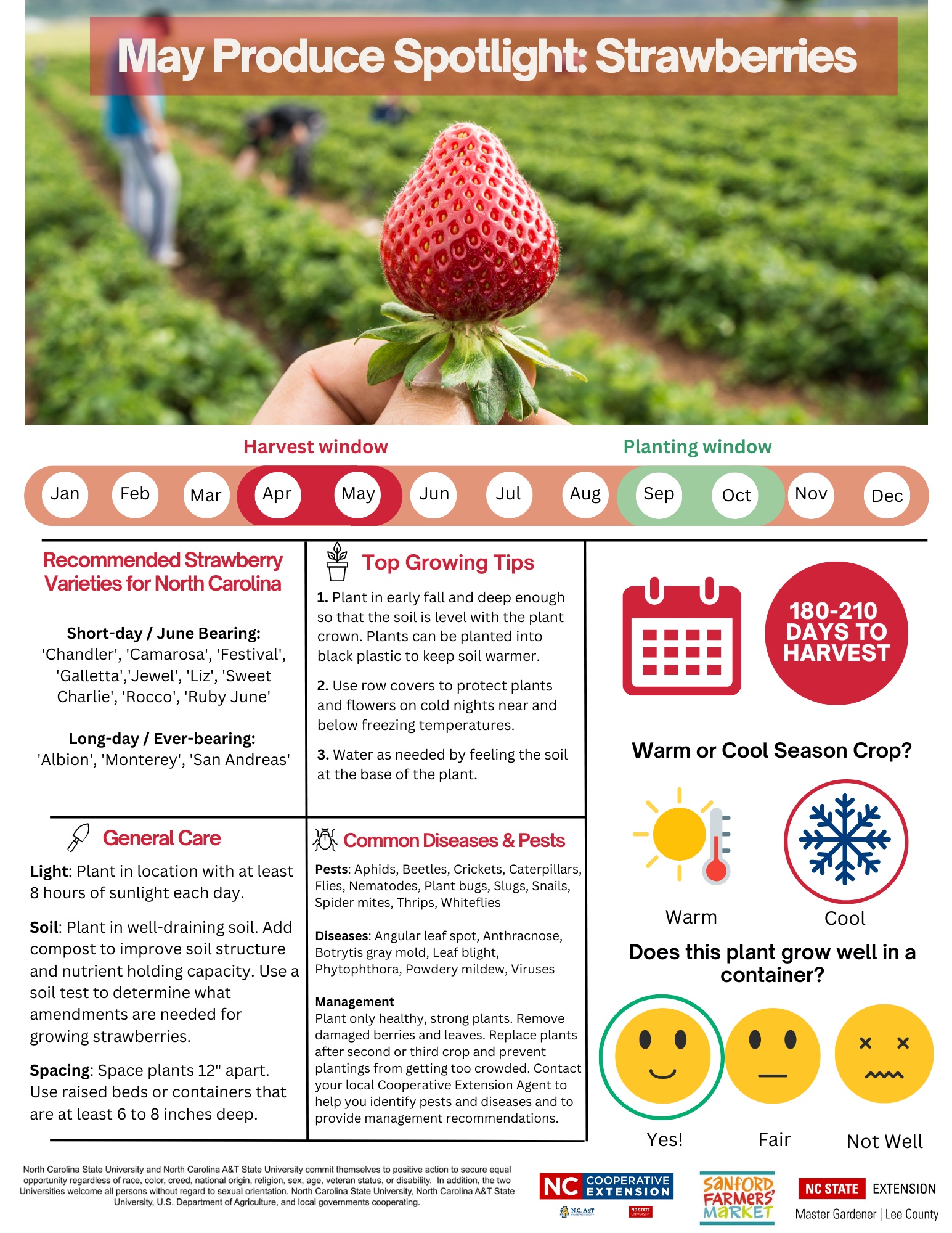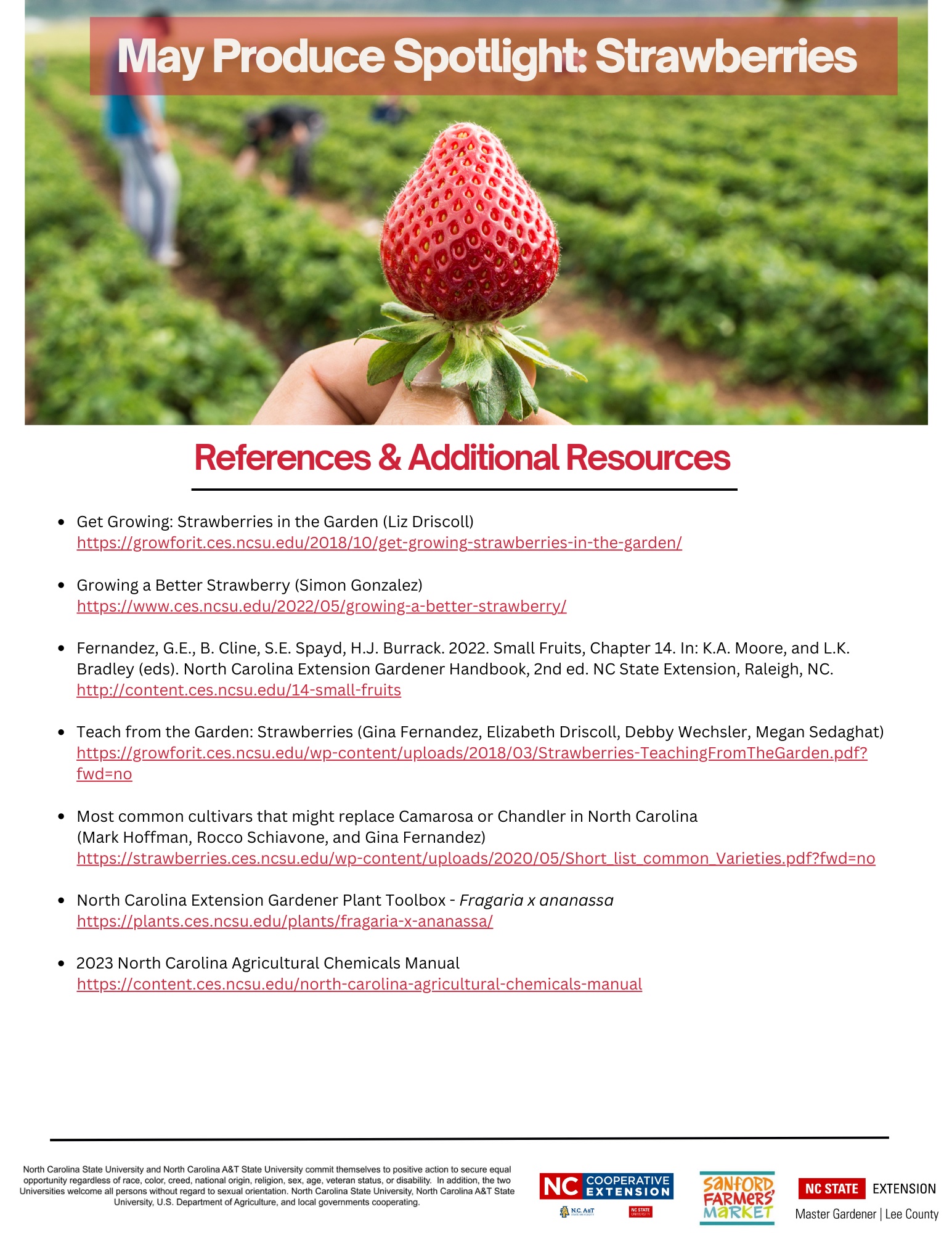May Is Strawberry Month
go.ncsu.edu/readext?933198
en Español / em Português
El inglés es el idioma de control de esta página. En la medida en que haya algún conflicto entre la traducción al inglés y la traducción, el inglés prevalece.
Al hacer clic en el enlace de traducción se activa un servicio de traducción gratuito para convertir la página al español. Al igual que con cualquier traducción por Internet, la conversión no es sensible al contexto y puede que no traduzca el texto en su significado original. NC State Extension no garantiza la exactitud del texto traducido. Por favor, tenga en cuenta que algunas aplicaciones y/o servicios pueden no funcionar como se espera cuando se traducen.
Português
Inglês é o idioma de controle desta página. Na medida que haja algum conflito entre o texto original em Inglês e a tradução, o Inglês prevalece.
Ao clicar no link de tradução, um serviço gratuito de tradução será ativado para converter a página para o Português. Como em qualquer tradução pela internet, a conversão não é sensivel ao contexto e pode não ocorrer a tradução para o significado orginal. O serviço de Extensão da Carolina do Norte (NC State Extension) não garante a exatidão do texto traduzido. Por favor, observe que algumas funções ou serviços podem não funcionar como esperado após a tradução.
English
English is the controlling language of this page. To the extent there is any conflict between the English text and the translation, English controls.
Clicking on the translation link activates a free translation service to convert the page to Spanish. As with any Internet translation, the conversion is not context-sensitive and may not translate the text to its original meaning. NC State Extension does not guarantee the accuracy of the translated text. Please note that some applications and/or services may not function as expected when translated.
Collapse ▲Spring is strawberry season here in North Carolina, and it’s a big deal for our state! NC currently ranks no. 3 in the nation for producing fresh market strawberries, with between 1,500 and 2,000 acres of farmland dedicated to producing these sweet fruits. Most farms growing strawberries in NC are small- to medium sized and offer them at their roadside stands or farms, including u-pick operations. In Lee County, many of our local farms have opened their doors to customers so that they can grab buckets of strawberries to enjoy during the short time these fruits are available.
There are many opportunities for you to celebrate strawberries in style this month in Lee County, and you can even consider growing your own strawberries at home this year! Read on below to learn more:
Things to do involving strawberries this month:
- Visit local strawberry farms and farmers’ markets
There are many farms growing strawberries in and around Lee County! You can use the Visit NC Farms App to find farms with roadside stands and strawberry u-pick opportunities near you. The app is free to download, and you can search for specific products you are interested in, like strawberries! Other resources that can help you to find farms offering u-pick options include PickYourOwn.org, NC Farm Fresh, and your local Cooperative Extension office.
Also check out your local farmers’ markets, there are lots of farmers offering strawberries during market hours! The Sanford Farmers’ Market just opened for the season and operates every Saturday morning from 8:30 a.m.-12 p.m. in Downtown Sanford. Other closeby markets include the Pittsboro Farmers’ Market, Carthage Farmers’ Market, Moore County Farmers’ Market, and Sandhills Farmers’ Market.
2. Celebrate strawberries at the Strawberry Jammin’ event!
A signature event in Sanford this time of year is Strawberry Jammin’, a weekend dedicated to celebrating strawberries and our local strawberry farms! Happening May 11-13 this year, this three-day event is packed with strawberry-themed food and fun, and finishes on Saturday with the Sanford Farmers’ Market and Strawberry Food Stroll in Downtown Sanford. Our local strawberry farmers will be bringing loads of berries to the market, and you can also enjoy food samples, music, and more! You can read more about the Strawberry Jammin’ event on the Visit Sanford website.
3. Plan and prepare to grow strawberries this fall
Are you interested in growing strawberries at home? Check out our produce spotlight factsheet on strawberries this month to learn more about how to grow these delicious, nutritious fruits!


Recommended Strawberry Varieties for North Carolina
Short-day/June Bearing:
‘Chandler’, ‘Camarosa’, ‘Festival’, ‘Galletta’, ‘Jewel’, ‘Liz’, ‘Sweet Charlie’, ‘Rocco’, ‘Ruby June’
Long-day/Ever-bearing:
‘Albion’, ‘Monterey’, ‘San Andreas’
Top Growing Tips
- Plant in early fall and deep enough so that the soil is level with the plant crown. Plants can be planted into black plastic to keep soil warmer.
- Use row covers to protect plants and flowers on cold nights near and below freezing temperatures.
- Water as needed by feeling the soil at the base of the plant.
General Care
Light: Plant in location with at least 8 hours of sunlight each day.
Soil: Plant in well-draining soil. Add compost to improve soil structure and nutrient holding capacity. Use a soil test to determine what amendments are needed for growing strawberries.
Spacing: Space plants 12″ apart. Use raised beds or containers that are at least 6 to 8 inches deep.
Common Diseases & Pests
Pests: Aphids, Beetles, Crickets, Caterpillars, Flies, Nematodes, Plant bugs, Slugs, Snails, Spider mites, Thrips, Whiteflies
Diseases: Angular leaf spot, Anthracnose, Botrytis gray mold, Leaf blight, Phytophthora, Powdery mildew, Viruses
Management
Plant only healthy, strong plants. Remove damaged berries and leaves. Replace plants after second or third crop and prevent plantings from getting too crowded. Contact your local Cooperative Extension Agent to help you identify pests and diseases and to provide management recommendations.




